“Design with Nature” philosophy guides Water Sustainability Action Plan for British Columbia
Note to Reader:
A request from Hans Peter Meyer, editor of the Communities in Transition Information Resource, was the trigger for writing the following historical retrospective on why ‘design with nature’ has become an integral and essential part of the green infrastructure and water sustainability branding in British Columbia.
To download a PDF version of this historical retrospective, click on “Design with Nature” philosophy guides Water Sustainability Action Plan for British Columbia.
Communities in Transition (CIT) is a signature program of the Real Estate Foundation of BC. CITinfoResource is a blog-based way of capturing some of the exciting ideas and stories that are taking place in British Columbia.

Design with Nature
“ Since 2004, the Water Sustainability Action Plan for British Columbia has championed the way-of-thinking and acting embodied in the phrase ‘design with nature’. We borrowed this phrase from the seminal book by Ian McHarg,” states Kim Stephens, Program Coordinator.
Since 2004, the Water Sustainability Action Plan for British Columbia has championed the way-of-thinking and acting embodied in the phrase ‘design with nature’. We borrowed this phrase from the seminal book by Ian McHarg,” states Kim Stephens, Program Coordinator.
“Over the years, our collective thinking has evolved as we have gained on-the-ground experience. By providing historical context, this article connects the dots. If communities design with nature, they can achieve settlement change in balance with ecology.”
About Ian McHarg
Ian McHarg was a renowned landscape architect and writer on regional planning using natural systems. His 1969 book Design with Nature pioneered the concept of ecological planning. His premise is simple: “that the shaping of land for human use ought to be based on an understanding of natural process.”
 His philosophy was rooted in an ecological sensibility that accepted the interwoven worlds of the human and the natural, and sought to more fully and intelligently design human environments in concert with the conditions of setting, climate and environment.
His philosophy was rooted in an ecological sensibility that accepted the interwoven worlds of the human and the natural, and sought to more fully and intelligently design human environments in concert with the conditions of setting, climate and environment.
Ian McHarg set his thinking in radical opposition to what he argued was the arrogant and destructive heritage of urban-industrial modernity, a style he described as “Dominate and Destroy.” In this book, he set forth basic concepts that were to develop later in Geographic Information Systems.
Water Sustainability Action Plan
Released in 2004, the Water Sustainability Action Plan for British Columbia builds on the foundation provided by A Water Conservation Strategy for British Columbia, published in 1998. Primary partnership initiatives comprise:
- the web-based Water Balance Model for British Columbia;
- the Green Infrastructure Partnership; and
- Convening for Action on Vancouver Island (CAVI).
Co-sponsored by the Province of British Columbia and the Real Estate Foundation of British Columbia, and delivered through the British Columbia Water & Waste Association (BCWWA), the Water Sustainability Action Plan is a partnership umbrella for aligning actions at three levels: provincial, regional and local.
“The Action Plan is the local government implementation interface for two over-arching provincial initiatives: Living Water Smart, BC’s Water Plan, and the Green Communities Initiative,” states Kim Stephens.
Convening for Action in British Columbia
“The Action Plan has evolved into a comprehensive program for convening for action in British Columbia,” explains Glen Brown, Executive Director with the  Ministry of Community & Rural Development. He is also Chair of the Water Sustainability Committee of the BCWWA.
Ministry of Community & Rural Development. He is also Chair of the Water Sustainability Committee of the BCWWA.
“Convening for action is our mantra. When we gather, it is for a purpose. There must be an action item or an outcome. Our aim is to move from talk to action by developing tools, building capacity, and providing training.”
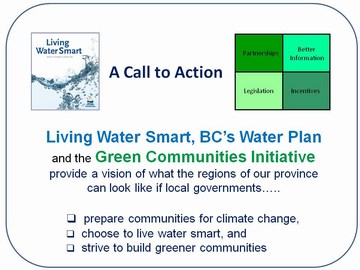
Water Balance Model Forums
 “The first time we applied the ‘design with nature’ branding for an outreach event was in February 2004 when the City of Chilliwack hosted the first of the Water Balance Model Forums,” recalls Ted van der Gulik, Senior Engineer with the Ministry of Agriculture & Lands. He is Chair of the Inter-Governmental Partnership (IGP) that developed the Water Balance Model.
“The first time we applied the ‘design with nature’ branding for an outreach event was in February 2004 when the City of Chilliwack hosted the first of the Water Balance Model Forums,” recalls Ted van der Gulik, Senior Engineer with the Ministry of Agriculture & Lands. He is Chair of the Inter-Governmental Partnership (IGP) that developed the Water Balance Model.
“We titled the Forum Designing with Nature: Celebrating the Chilliwack Experience in Implementing Sustainable Community Design.”
Design with Nature Game Show
“In 2005 and 2006, the City of Kelowna and APEGBC co-sponsored a Water Balance Model seminar and training workshop, respectively,” states Kim Stephens.
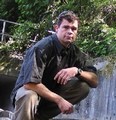 “These events provided Richard Boase (District of North Vancouver) with his window of opportunity to experiment and engage audiences with the Design with Nature Game Show. The ‘game show’ was similar to the television show Jeopardy in that participants worked in teams and were asked to respond to photographs by stating “What design with nature means is…”
“These events provided Richard Boase (District of North Vancouver) with his window of opportunity to experiment and engage audiences with the Design with Nature Game Show. The ‘game show’ was similar to the television show Jeopardy in that participants worked in teams and were asked to respond to photographs by stating “What design with nature means is…”
“It was a way of having some fun at the start of the day,” recalls Richard Boase, IGP Co-Chair. “It loosened the group up. It got them thinking about real things, on the ground, so that they could begin to see how use of the Water Balance Model would help them in their day jobs. It was fascinating to see how excited and ‘into it’ people get after a few minutes. If people have fun, perhaps some of the philosophical stuff will actually stick.”
Why Design with Nature
“The suggestion to adopt the ‘design with nature’ branding originated with Erik Karlsen, then with the Ministry of Municipal Affairs, and more recently Chair of the Agriculture Land Commission until he retired this year,” continues Kim Stephens.  “Erik was an active member of the Water Sustainability Committee at the time.”
“Erik was an active member of the Water Sustainability Committee at the time.”
“Years before, another suggestion by Erik Karlsen was the seed that eventually flowered as the Water Balance Model.” To learn more, click on A Look Back to the SmartStorm Forum Series: Genesis for the Water Balance Model.
“The design with nature imagery resonated with the IGP. It resonated because ‘design with nature’ captured the key message that the partner ministries and local governments wished to convey: the tool is a means to end…. the vision is to change the way we develop land…. it is about a different way of thinking.”
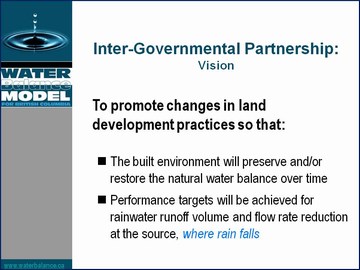
Green Infrastructure Partnership
“The next step in the evolution of the ‘design with nature’ branding took place in May 2005. The catalyst was a consultation workshop organized by the Green Infrastructure Partnership. This was undertaken in collaboration with Metro Vancouver’s Regional Engineers Advisory Committee, and  was hosted by the City of Surrey,” states Kim Stephens.
was hosted by the City of Surrey,” states Kim Stephens.
“At that time, Paul Ham was Chair of the Green Infrastructure Partnership. He was also Surrey’s City Engineer. It was Paul who identified the need to translate ‘design with nature’ into language that would resonate with his REAC colleagues. It was Paul who suggested how we could go about re-framing what Patrick Condon and Smart Growth BC in particular were advocating.”
What ‘Design with Nature’ Means
“The Green Infrastructure Partnership created a mind-map comprising a set of six sound-bites. The steering committee gave a lot of thought to the choice of verbs. They are intentionally pragmatic and action-oriented,” continues Kim Stephens.
 “In practical terms, what designing with nature means…is essentially a restatement of Smart Growth principles,” explains Ray Fung, Director of Engineering & Transportation with the District of West Vancouver. He is also the current Chair of the Green Infrastructure Partnership.
“In practical terms, what designing with nature means…is essentially a restatement of Smart Growth principles,” explains Ray Fung, Director of Engineering & Transportation with the District of West Vancouver. He is also the current Chair of the Green Infrastructure Partnership.
In 2006, the District of West Vancouver formally embraced ‘design with nature’ in its Sustainable Future: 3 Year Corporate Business Plan 2006 – 2008.
“Speaking from the perspective of the Green Infrastructure Partnership, what we have found is that the term Smart Growth is sometimes highly charged and political. People often get their backs up because they associate ‘smart growth’ as being all about imposing higher density development.”
“We find that people intuitively understand what designing with nature means. It is non-threatening.”
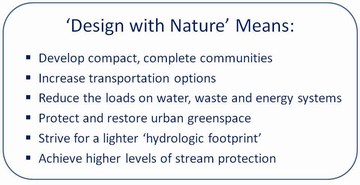
Convening for Action on Vancouver Island
Launched in September 2006 in conjunction with the Water in the City Conference, the CAVI initiative is now in its fourth year of collaborating with local governments and others under the umbrella of the Action Plan.
 “The CAVI vision is to move toward water sustainability by implementing green infrastructure policies and practices. CAVI has defined green infrastructure in terms of a ‘design with nature’ approach to climate change adaptation,” states John Finnie, CAVI Chair. In his day job, he is General Manager, Regional & Community Utilities, with the Regional District of Nanaimo.
“The CAVI vision is to move toward water sustainability by implementing green infrastructure policies and practices. CAVI has defined green infrastructure in terms of a ‘design with nature’ approach to climate change adaptation,” states John Finnie, CAVI Chair. In his day job, he is General Manager, Regional & Community Utilities, with the Regional District of Nanaimo.
Green Vocabulary Explained
To facilitate a common understanding plus help advance a new way-of-thinking about land development, CAVI and the Green Infrastructure Partnership developed the following hierarchy of ‘green’ vocabulary:
- Green Valueis a generic reference to use and conservation of land and real estate that achieves social and economic goals while minimizing harmful effects on ecological assets.
- Design with Nature is one approach to achieve Green Value, and is supportive of community goals that relate to building social capacity.
- Green Infrastructure is the on-the-ground application of Design with Naturestandards and practices.
- Water Sustainability is achieved through Green Infrastructure practices that reflect a full and proper understanding of the relationship between land and water.
This cascading vocabulary was unveiled at the Creating Our Future Workshop that was held in conjunction with the Gaining Ground Summit in Victoria in June 2007.
Bowker Creek Blueprint
“The Bowker Creek Blueprint is precedent-setting and demonstrates how to apply a ‘design with nature’ approach to urban watershed restoration,” states Kim Stephens. “Lessons learned can be transferred and adapted to other settings.”
A 100-Year Action Plan: Bowker Creek is located in the urbanized heartland of the Capital Regional District. “The Blueprint is a 100-year action plan,” states Jody Watson, Chair of the Bowker Creek Initiative.
100-Year Action Plan: Bowker Creek is located in the urbanized heartland of the Capital Regional District. “The Blueprint is a 100-year action plan,” states Jody Watson, Chair of the Bowker Creek Initiative.
“The Blueprint is to be implemented over a period of decades because change can be slow in the urban environment. The 100-year timeframe has made it possible for everyone to commit to doing their part to make the restoration vision real.”
 A New Form of Governance: “The Bowker Creek Blueprint is an outstanding and inspiring accomplishment,” states Eric Bonham, a founding member of CAVI and a former Director in two provincial Ministries. “The Bowker 100-Year Action Plan demonstrates how a ‘top down bottom up strategy’ leads to practical action. It has the power to positively influence what happens in other parts of the Georgia Basin.”
A New Form of Governance: “The Bowker Creek Blueprint is an outstanding and inspiring accomplishment,” states Eric Bonham, a founding member of CAVI and a former Director in two provincial Ministries. “The Bowker 100-Year Action Plan demonstrates how a ‘top down bottom up strategy’ leads to practical action. It has the power to positively influence what happens in other parts of the Georgia Basin.”
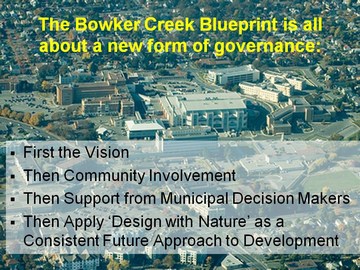
Climate Change Adaptation
“In 2008, two developments led to the further refinement of the ‘design with nature’ mind-map,” recalls Kim Stephens. “The first was the action by the Metro Vancouver Board in April to appoint a Reference Panel to provide independent review and recommendations on the Liquid Waste Management Plan update. The second development was release of Living Water Smart by the Province in June.”
Living Water Smart
“By choosing to live water smart, communities will be more prepared for climate change and their quality of life will be enhanced. If we can show how to get the water part right, then other parts are more likely to follow,” states Lynn Kriwoken of the Ministry of Environment. A Director in the Water Stewardship Division, Lynn  Kriwoken is the Province’s lead person for development and delivery of Living Water Smart.
Kriwoken is the Province’s lead person for development and delivery of Living Water Smart.
Collaborate: According to Lynn Kriwoken, the ‘design with nature’ paradigm captures the essence of climate change adaptation. “Adaptation is about responding to the changes that will inevitably occur. Adaptation is at the community level and is therefore about collaboration,” she says.
Integrated Liquid Resource Management
The Metro Vancouver Reference Panel is a community advisory group that reports directly to the regional elected representatives. The panel’s expert knowledge and relevant experience in liquid waste/resource and rainwater management has influenced development of Metro Vancouver’s Integrated Liquid Waste & Resource Management Plan.
 Re-Use Resources: “When the Reference Panel reported back to the politicians for the first time in July 2008, we introduced them to the design with nature mind-map. The Reference Panel made one material change. We integrated re-use of resources language,” states Christianne Wilhelmson, Reference Panel Co-Chair and Managing Director for the Georgia Strait Alliance.
Re-Use Resources: “When the Reference Panel reported back to the politicians for the first time in July 2008, we introduced them to the design with nature mind-map. The Reference Panel made one material change. We integrated re-use of resources language,” states Christianne Wilhelmson, Reference Panel Co-Chair and Managing Director for the Georgia Strait Alliance.
“The Georgia Strait Alliance had been presenting to Metro Vancouver since 2006 about the need for resource re-use. We had also talked about the importance of a change in language….. because this is part of the process of advancing change. The design with nature mind-map provided an effective way to both re-emphasize and bring together these points. The mind-map resonated.”
The Current Design with Nature Mind-Map:
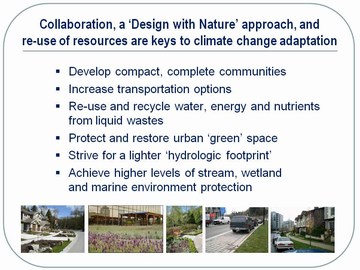
Settlement Change in Balance with Ecology
The need for an approach that balances settlement change and ecology was first introduced by Tim Pringle at the Mini-Summit on Water for Life and Livelihoods, held in Whistler in May 2006. Since then he has progressively evolved the concept through his contributions to successive CAVI program elements. Tim Pringle is Director of Special Programs for the Real Estate Foundation.
“The phrase Settlement Change in Balance with Ecology is now an essential element of the branding for Convening for Action in British Columbia,” states Kim Stephens. “Through outreach and education, the Action Plan vision is to influence land and water practitioners to learn about land use practices that better balance settlement activity and ecological assets in local and regional landscapes.”
To learn more, click on How does a community weigh the benefits and liabilities of change driven by demand for land use?
Balance Requires Measurement
“The key principle is that settlement and ecology are equal values and they must be as much in balance as possible for wellbeing of human and natural systems,” states Tim Pringle.
 “A reality is that we manage what we can measure. While we are very good at measuring settlement, mainly in financial terms, we have not been that effective in quantifying the ecological implications and/or impacts associated with the rapid pace of development that BC has been experiencing. This disconnect in measuring what matters has resulted in an unbalanced approach when making development decisions.”
“A reality is that we manage what we can measure. While we are very good at measuring settlement, mainly in financial terms, we have not been that effective in quantifying the ecological implications and/or impacts associated with the rapid pace of development that BC has been experiencing. This disconnect in measuring what matters has resulted in an unbalanced approach when making development decisions.”
Change the Land Ethic: “If we were in fact measuring ecological values, there would be more ‘weights’ (reliable data) on the ecology side of the balance scale; thus leading to more informed conclusions and hence different decisions.”
“As communities develop and/or redevelop, the desired outcome in ‘designing with nature’ is that settlement change will be in balance with ecology. It is all about changing the land ethic,” concludes Tim Pringle.
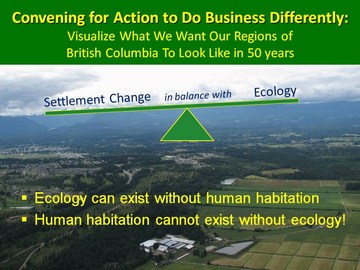
Posted March 2010

